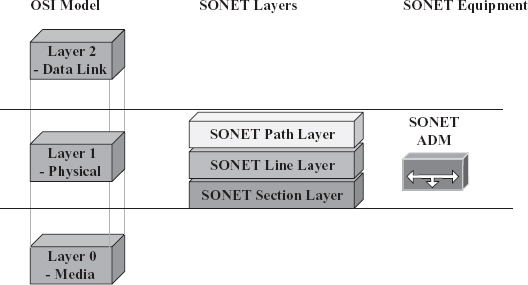4
SONET
4.2.1 SONET Transmission Rates
4.2.2 SONET Network Architectures
4.3.2 Synchronous Payload Envelope
4.3.3 SONET Virtual Tributaries
4.4.3 SONET Terminal Multiplexer
4.5 SONET Implementation Features
4.5.2 SONET Clock Distribution
4.1 INTRODUCTION
The synchronous optical network (SONET) is a standard for optical telecommunications transport established by ANSI in the 1980s. Its European and Japanese counterpart, the synchronous digital hierarchy (SDH), was formulated by the ITU standards body. The differences between the two standards are reasonably small for our purposes, so in this chapter, we will, for the most part, use only the term SONET. However, almost anything written about SONET will apply to SDH, sometimes with small modifications, which occasionally are mentioned.

FIGURE 4.1 OSI model, SONET Layers, and examples of networking equipment.
SONET uses time-domain multiplexing (TDM) as a way to multiplex lower-bandwidth signals into one high-capacity signal that can be sent over optical fiber. Being a networking standard, it provides a set of specifications to determined frame formats, bit rates, and optical conditions ...
Get Network Infrastructure and Architecture: Designing High-Availability Networks now with the O’Reilly learning platform.
O’Reilly members experience books, live events, courses curated by job role, and more from O’Reilly and nearly 200 top publishers.

